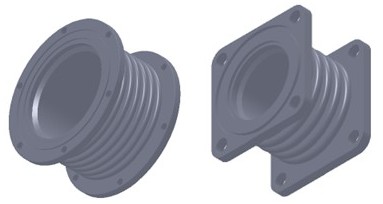1, What is an expansion joint ?

An expansion joint is a device that contains one or more bellow elements, which is used to assist with structural changes, such as those produced by the thermal expansion or tightening of a pipes, tubes, or vessels. It can be used to allow movement in a pipeline system.
The bellow element is a flexible part of an expansion joint that normally consists of several convolutions. The expansion joint is the best solution when making a piping system more elastic. Flexibility is needed when there are different movements in a pipeline such as, frequent vibrations, pulsations and thermal growth.
2, Movements- What kind of movements can an expansion joint absorb?
There are three basic types of movement that can be applied to the expansion joins and these are: Axial movement, Lateral movement and Angular deflection as illustrated below.
 Axial movement | Axial movement is the free length of the expansion joints stretching or compressing along its longitudinal axis. |
 Lateral movement | Lateral movement is a movement of the two ends of the expansion joints where those ends stay parallel to each other but not in one plane. |
 Angular deflection | Angular deflection is the displacement of the longitudinal axis of the Expansion joint from its initial straight line position in to a circular arc. |
3, Cycle life
This is the primarily the most important factor in good bellows design. In addition to the stroke, the cycle life required determines the number of convolutions needed in the bellow elements and this also determines the amount of stress acting upon the bellow elements.
4, Pressure thrust
Pressure thrust is the force created by pressure acting on a bellows. This force is the system pressure times the effective area of the bellows. When a piping system without expansion joints is pressurized, the system will not move because the pipe is countering the force in tension. When an unrestrained expansion joint is introduced in the network, the force tends to pull the ends away from the expansion joint causing damage to itself and the pipe. This pressure thrust must be contained with either main anchors or restrained expansion joints designed to carry pressure thrust loads. The main anchors must be able to resist the pressure thrust force and a small amount of force due to the deflection of the bellows.
5, Accessories- How can I upgrade my expansion joint to handle different conditions?
Limit rods: a "fail-safe" addition which addresses the situation of occasional anchor overload or system malfunction which could cause expansion joints beyond tolerance.
Liners: internal liners used to protect the internal surface of the metal bellows from media which may compromise its integrity.
Connections: used in tandem with liners, keep the bellows within high temperature tolerance conditions, such as oil industry applications.
Covers: are used to protect the expansion joints from any detrimental external elements.
Pipe Alignment Guides: control thermal expansion in the system so that the movement applied to the bellows assembly is axial only.
6, Installation guide
1), The bellows element shall be protected from damage such as dents, arc strikes, weld spatter, and other damage can cause the joint to fail. ALWAYS protect the bellows element from burn splatter with a flame-retardant cloth or other shielding material. Damage joints are forbidden to be used.
2), Align joint flange and pipe flange holes. Do not try to compensate for flange (vanstone flanges permit some rotational misalignment) or pipe misalignment by putting any torsional, compressive, extension, or offset loads on the expansion joints. If a bellows is subjected to torsional forces due to hole misalignment, it will reduced cycle life and/or bellows failure can occur. Good practice suggests that a mating flange in the piping system remain unwelded until the expansion joint has been bolted in position.
3), All anchors, guides, and supports must be installed according to engineering drawing and specifications.
4), When expansion joints are fitted with liners or internal sleeves, the unit will be marked with an arrow indicating the direction of flow. So the expansion joints should be installed in the proper orientation according to the direction of flow.
5), Unit lengths must not be altered during installation except for the application of cold pull.
6), Remove shipping restraints after installation, but before hydrotesting.
7), If testing medium is significantly heavier than the product to be carried in the system, care must be taken to support the additional weight.
8), Paints containing low melting point metals or other compounds, particularly aluminum lead or zinc, must not be allowed to come into contact with the bellows convolutions.
9), All installation procedures should conform to E.J.M.A Safety Recommendations in Section B.
10), Expansion joints must be easily accessible to allow for period inspection. Bellows should be inspected for any signs of damage such as dents or scores. Damaged expansion joints should be replaced immediately.
11), Final System Check - After installation has been completed and shipping bars removed, check all anchors, guides, and pipe supports. Slowly apply test pressure to the system, checking for any unusual movement of the bellows anchors or guides. If irregular movement is observed, immediately lower the pressure and re-examine the system for damage.
Note : Test pressure should not exceed 1-1/2 times of the design pressure.



